This is the second ‘Prelude Post’ for the Mirrix Loom Weave Along for the Soumak Pouch.
The pouches are perfect for both business cards:
or for cellphones:
My cellphone is one of the smaller, lower tech ones [4inches tall, 2 inches wide, 5/8 inch thick] if yours is larger, then you will want to upsize your pouch, if your pouch is going to be a cellphone pouch.
Alright… now onto the gathering up of tools and equipment:
First of all, you need a loom:
Most of the photos and videos for the weave along will feature my 8 inch Lani Mirrix loom. (Although I have ordered a Mini and a Little Guy, so hopefully, they will arrive soon, so I can use them in the photos and videos, too.)
The pouch can also be woven on any of the larger Mirrix looms as well- if you are using one of the smaller Mirrix looms, then warp up one pouch at a time. If you are using one of the larger looms, then you can warp and weave 2 pouches at the same time.
Even if you don’t have a Mirrix loom, please feel welcome to join in the Weave Along.
As long as you have a loom that you can get good tight tension on it, then you will be able to weave the pouches.
You will also need: A steam iron, a pressing cloth, a good source of light, pencil crayons or watercolors or some other way of coloring your preliminary pattern colorways, 2 clothespins, scissors, needle and thread for finishing, snap fastener and a swivel clip, you’ll also need paper for tracing out your patterns and trying out different color schemes.
Knitting needles and crochet hooks are very helpful, and a loop turning tool is handy (I bought mine at my local fabric store), a piece of cardboard that is 10 inches tall by 3 inches wide (25 cm tall by 7.5 cm wide), a weaving stick, small paper clamps, a fork or beater, a hole punch, at least a yard of firm yarn or cord, clear tape (packing tape works well); a black fine tip permanent marker
You’ll need rods for the top and lower edge of the weaving: 6 inch (15 cm) tent pegs or 6 inch (15 cm) lengths of steel or brass rods 1/8 inch in diameter (I bought a 36 inch long one at the hardware store and cut it to 6 inch lengths with a hacksaw); velcro straps (I bought mine from Lee Valley: Link; ‘S’ HOOKS: 25 “S” hooks, either 7/8 inch or 1 inch- opened or closed :[ I had a huge ‘AHA’ when I bought closed ‘S’ hooks…. having one end closed is just GREAT… so if you buy closed ‘S’ hooks, open one end with pliers. If you buy open ‘S’ hooks, squeeze one of the ends closed. Having the closed end keeps the ‘S’ hooks on the rod. 🙂 ] ; 1/4 inch Washers: 54 in total; 1 or 2 pairs of pliers for adjusting the ‘S’ hooks; ruler and tape measure.
Some of these things have shown up in other photos, so I won’t list them again, but the other things are: A small bowl for holding pins, needles, clamps etc; a bag or box to store and transport the project (that’s Tottie Tomato’s knitting bag); chopsticks are very handy for several things besides your Pad Thai 🙂
You will need at least 5 or 6 blunt tapestry or craft or darning needles. It’s handy to have a needlebook or tin, or cardboard tube or eyeglass case to store them in.
To line the pouch: Fabric (I upcycled one of my son’s abandoned t shirts for the lining of the first 4 bags), scissors, pins, needle and thread, snap fastener: I used the 15 mm size.
To make the edging cord: A kumihimo kit
OR a spool knitter: Lion Brand: LINK
or Harrisville: LINK
CHECKLIST at a glance:
– Loom
– steam iron
– pressing cloth
-a good source of light
– pencil crayons or watercolors or some other way of coloring your preliminary pattern colorways
– paper for tracing out your patterns and trying out different color schemes
– 2 clothespins
-scissors
-needle and thread for finishing
-snap fastener 15 mm size
-swivel snap hook (optional)
-knitting needles & crochet hooks
-Optional: a loop turning tool is handy
-a piece of cardboard that is 10 inches tall by 3 inches wide (25 cm tall by 7.5 cm wide)
– a weaving stick
– small paper clamps
-a fork or beater
-a hole punch
-at least a yard of firm yarn or cord
-clear tape (packing tape works well)
-a black fine tip permanent marker
–Rods for the top and lower edge of the weaving: 6 inch (15 cm) tent pegs or 6 inch (15 cm) lengths of steel or brass rods 1/8 inch in diameter
-velcro straps Link
–‘S’ HOOKS: 25 “S” hooks, either 7/8 inch or 1 inch- opened or closed
– 1/4 inch Washers: 54 in total
-1 or 2 pairs of pliers for adjusting the ‘S’ hooks
-ruler and tape measure
– small bowl for holding pins, needles, clamps etc
– a bag or box to store and transport the project
– chopstick (optional)
– At least 5 or 6 blunt tapestry or craft or darning needles and a needlebook or tin, or cardboard tube or eyeglass case to store them in.
-Lining fabric
– Straight pins
-kumihimo kit OR a spool knitter
-any other embellishments, beads, buttons, charms or found objects that you wish to use.














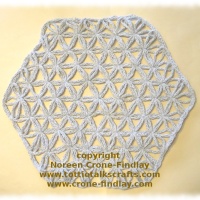

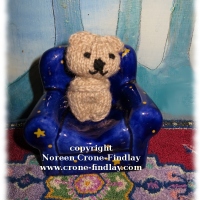
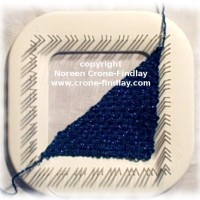
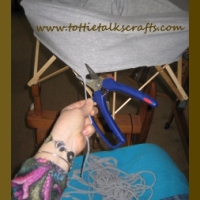

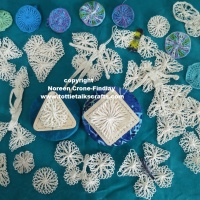

Noreen – What is a loop turning tool? ~Doreen
LikeLike
Hi Doreen
In the fifth photo from the top, the long thin tool second from the left is a loop turning tool. It is a small latch hook, like a knitting machine latch hook, on a 12 inch long wire handle. It’s wonderful for weaving in ends. I buy them at the fabric store and use them in weaving. A very useful tool, indeed! 🙂
LikeLike
Noreen, If you are warping 2 pouches at the same time can one be cotton and one of them wool?
LikeLike
Hi Bobbie
I would use the same warp for both, as different warp fibers can react to tension in their own unique way. The weft can be wool or cotton or whatever you choose, but I would be cautious about having wool and cotton warps on at the same time. This is a good thing to experiment with, though, as I haven’t tried using different warps.
If you do, could you let me know how it goes? Thanks! 🙂
LikeLike
Pingback: Mirrix Loom Weave Along Soumak Pouch- All the links | Tottie Talks Crafts Blog
Pingback: Mirrix Looms Weave Along #8 Soumak Pouch-ALL the links |